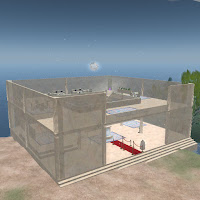There was something remarkable to me about this: Keao has been blind from birth. What sort of "picture" for this ballroom did she have in her mind, if she has been blind her whole life? She was conveying her idea to me, but what was the idea itself like, in her mind? For me, it would have been a mental picture. But for her, I wondered, what? I asked her, and she said, "I just have an idea of it." She couldn't describe the form it took. She just knew.
We all carry representations (mental maps) of the spaces around us inside our heads. They're what make it possible to find our way, whether it be through our homes, or our communities at large. We all have mental maps, whether we're sighted or blind. But what do these "look" like, for someone who's blind?
People who are blind do have spatial representations in their minds. They just don't happen to "encode" the information with their eyes. They encode it by sound and by feel. Blind people read Braille using their spatial encoding abilities when they're reading a line or page of text by feel.
The picture with this post (below) says YOU ARE HERE in Braille. (It's a view of the raised dots as seen at an angle, from the lower right.) It's not a mental picture that a blind person sees in their mind when they read in Braille, but they still have a mental construct of what they feel. They have a spatial representation of those dot patterns inside their mind. Without it, Braille makes no sense.
 If you are able to touch-type, without looking at the keyboard, you're using a similar, non-visual
spatial construct. Without any visual guide, your mind knows spatially
where the correct keys are. You type by feel. It's as simple as that.
If you are able to touch-type, without looking at the keyboard, you're using a similar, non-visual
spatial construct. Without any visual guide, your mind knows spatially
where the correct keys are. You type by feel. It's as simple as that.It turns out that the "visual cortex" region of the brain is a misnomer. It's more the "spatial cortex". It's as active in a person who's blind as one who's sighted. Just because a blind person does not see a mental map in their mind doesn't mean they don't use one. Spatial is not always visual, and a mental map is not always a picture. Imagine that!

What a wonderful post, Jadyn! Awesome.
ReplyDelete